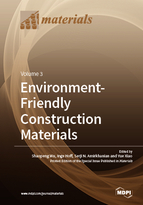Environment-Friendly Construction Materials
A special issue of Materials (ISSN 1996-1944).
Deadline for manuscript submissions: closed (15 February 2019) | Viewed by 190204
Special Issue Editors
Interests: asphalt based road construction materials; pavement structure design; solid waste utilization
Special Issues, Collections and Topics in MDPI journals
Interests: materials for transport infrastructure; environmental impact of pavement materials
Interests: construction materials; recycling issues and polymers; rubber tire recycling
Interests: solid waste recycling in road engineering; road and pavement materials; asphalt pavement maintenance
Special Issues, Collections and Topics in MDPI journals
Special Issue Information
Dear Colleagues,
The 1st International Conference on Sustainable Mega Infrastructures (SMI 2018) and the 3rd International Conference on Sustainable Construction Materials: Design, Performance and Application (SCM2018) will be held in Donghu Hotel, Wuhan City, Hubei, China, on 10-11 August 2018. This conference is sponsored by the Wuhan University of Technology (WUT), the Norwegian University of Science and Technology (NTNU) and the University of Alabama.
The SCM conferences have been a successful and a longstanding event since 2010, which bring together academic researchers and civil engineers from the world to promote technological achievement in sustainable construction materials. SMI2018 and SCM2018 will once again provide a unique opportunity to discuss the strategies and challenges related to the planning, execution and use of mega infrastructures, as well as sustainable construction materials. The scope of SMI2018 and SCM2018 will include, but is not limited to, cementitious paving materials, bituminous paving materials, recycled materials, waste materials, and so on.
The SMI2018 and SCM2018 will prepare diverse programs, including a plenary/keynote sessions, oral/poster sessions, exhibitions, and social events. This Special Issue was proposed based on the productive abstract submissions. Participants at SMI2018 and SCM2018 are highly encouraged to submit papers in this Special Issue for possible publication in Materials. Authors who would not attend the SMI2018 and SCM2018 conference are also warmly invited to submit a paper for this Special Issue.
Prof. Dr. Shaopeng Wu
Prof. Dr. Inge Hoff
Prof. Dr. Serji Amirkhanian
Assoc. Prof. Dr. Yue Xiao
Guest Editors
Manuscript Submission Information
Manuscripts should be submitted online at www.mdpi.com by registering and logging in to this website. Once you are registered, click here to go to the submission form. Manuscripts can be submitted until the deadline. All submissions that pass pre-check are peer-reviewed. Accepted papers will be published continuously in the journal (as soon as accepted) and will be listed together on the special issue website. Research articles, review articles as well as short communications are invited. For planned papers, a title and short abstract (about 100 words) can be sent to the Editorial Office for announcement on this website.
Submitted manuscripts should not have been published previously, nor be under consideration for publication elsewhere (except conference proceedings papers). All manuscripts are thoroughly refereed through a single-blind peer-review process. A guide for authors and other relevant information for submission of manuscripts is available on the Instructions for Authors page. Materials is an international peer-reviewed open access semimonthly journal published by MDPI.
Please visit the Instructions for Authors page before submitting a manuscript. The Article Processing Charge (APC) for publication in this open access journal is 2600 CHF (Swiss Francs). Submitted papers should be well formatted and use good English. Authors may use MDPI's English editing service prior to publication or during author revisions.
Keywords
- Social and economic aspects of mega projects
- Asphalt-based & cement-based mixtures
- Pavement engineering
- Environmental impact
- Sustainable materials
- Planning process
- Digitalization of mega infrastructures
- Pavement maintenance










